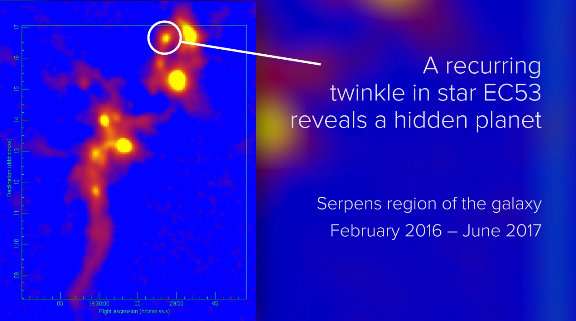18-month twinkle in a forming star suggests the existence of a very young planet

An international team of researchers have found an infrequent variation in the brightness of a forming star. This 18-month recurring twinkle is not only an unexpected phenomenon for scientists, but its repeated behavior suggests the presence of a hidden planet.
This discovery is an early win for the James Clerk Maxwell Telescope (JCMT) Transient Survey, just one-and-a-half years into its three-year mandate to monitor eight galactic stellar nurseries for variations in the brightness of forming stars. This novel study is critical to understanding how stars and planets are assembled. The survey is led by Doug Johnstone, Research Officer at the National Research Council of Canada and Greg Herczeg, Professor at Peking University (China), and is supported by an international team of astronomers from Canada, China, Korea, Japan, Taiwan and the United Kingdom.
"This variation in the brightness or twinkle of the star EC53 suggests that something large is disrupting the gravitational pull of the forming star. The fact that it recurs every 18 months suggests that this influence is orbiting around the star – it's quite likely a hidden, forming planet," says Doug Johnstone. It is thought that a companion planet is orbiting the star, and its passing gravitational pull disrupts the rate of the gas falling onto the forming star, providing a variation in the observed brightness, or light curve, of the star.
Young stars are born in regions of the galaxy where molecular gas is abundant. When the star is young, gas and dust form a thick cloud that surrounds the star. Some of this material quickly flattens into a disk, in which planets will form. The cloud blocks the star itself from optical view, so astronomers study the star indirectly by using the cloud to learn details about the star growing inside. The star builds up its mass as gravity attracts gas to move from the disk onto the star, a process that also releases significant energy that heats up the surrounding gas cloud. Astronomers use telescopes sensitive to sub-millimetre wavelengths, like the JCMT, to measure the cloud brightness and reveal details about the growth of the star.
EC53's light curve anomaly was discovered by Hyunju Yoo, graduate student at Chungnam National University and advisor Jeong-Eun Lee, Professor at Kyung Hee University (South Korea), through careful analysis of monthly observations of Serpens Main, a stellar nursery known to contain many forming stars. Although the brightness of EC53 has been observed to vary periodically at near-infrared wavelengths for some time, these sub-millimetre observations were essential in validating that the brightness variation was due to heating from gas accreting onto the forming star, rather than variations in the cloudiness of the environment.
"What caught my eye was a new round of data that showed a sudden brightness that hadn't existed in previous observations," says Lee. "I knew that something unique and interesting must be happening around this forming star. It turned out that it is indeed a very special object, providing a new window into how stars and planets form."
A deeper understanding of the formation of stars and planets
For the remainder of the three-year sub-millimetre survey, the team will continue to monitor EC53 and will also be searching for additional young stars showing variations in growth to learn more about how stars and planets assemble. There are already a half-dozen additional candidate variables within the survey. By studying these stars, and using additional telescope facilities such as the powerful Atacama Large Millimeter/submillimeter Array (ALMA) in Chile, the study will provide new and unique insight into the timescale for the formation of stars and planets, including whether planets form during or after the assembly of the star.
"This discovery marks a turning point; in a sense, it's like sub-millimetre astronomy is moving from taking pictures of our galaxy to taking videos," says Greg Herczeg. "The last 25 years have been devoted to perfecting observing techniques and instruments to allow us to see early star formation. But with recent advances in technology, we can now observe regions changing over time, for a deeper understanding of how stars form. This discovery is just one example of how much more we can now learn."
Monitoring the brightness of forming stars over time using sub-millimetre wavelengths is an unconventional approach to observing that has been made possible by recent advances in imaging technology, like SCUBA-2, and data reduction processing which enables precise calibration and measurement.
The JCMT resides at the summit of Maunakea in Hawaii and is the largest single-dish sub-millimetre telescope in the world. The JCMT is operated by the East Asian Observatory, a partnership between China, Taiwan, South Korea and Japan, with support from the astronomy communities in Canada and the United Kingdom. The university-led contributions from Canada are supplemented by the NRC's support for the JCMT archive at the Canadian Astronomy Data Centre.
This discovery has been accepted for publication in Astrophysical Journal.
More information: Hyunju Yoo et al. The JCMT Transient Survey: Detection of Submillimeter Variability in a Class I Protostar EC 53 in Serpens Main, The Astrophysical Journal (2017). DOI: 10.3847/1538-4357/aa8c0a
Journal information: Astrophysical Journal
Provided by The National Research Council



















